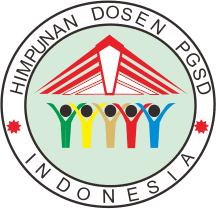Pengaruh case based learning terhadap hasil belajar kognitif mahasiswa ditinjau dari computational thinking
Abstract
The case-based learning model provides students with the opportunity to be effectively involved in the learning process so that they can construct their own knowledge. The purpose of this study was to determine the effect of case-based learning models on students' cognitive learning outcomes in terms of computational thinking. This study is a quantitative study. The sample was selected using cluster random sampling techniques. Data collection was carried out using essay test techniques to measure cognitive learning outcomes and computational thinking, as well as a scale to measure the level of student preference for learning. Validity testing was carried out using Aiken's V validity. Data analysis was carried out using Analysis of Variance (ANOVA). The results of this study are as follows. The results showed a positive effect of case-based learning models on the cognitive learning outcomes of UNS PGSD students. There was no significant effect between students' computational thinking and their cognitive learning outcomes. There was no interaction between case-based learning models and computational thinking skills with the cognitive learning outcomes of UNS PGSD students. Based on these results, it can be concluded that case-based learning models have an effect on students' cognitive learning outcomes. However, there was no effect between learning outcomes and computational thinking skills, and there was no interaction between case-based learning models and students' computational thinking skills. The results of this study can be used as a reference for further research.
Keywords
Full Text:
PDFReferences
[1] H. Saleh Adri, “Pendidikan Sebagai Human Investasi,” J. Manag. Econ. Account., vol. 1, no. 1, pp. 26–40, 2022, [Online]. Available: https://pusdikra-publishing.com/index.php/jisc
[2] PISA, “PISA 2022 Results Factsheets Indonesia,” Lang. Sci. Educ., vol. 1, pp. 1–9, 2023.
[3] J. Juhaeni, S. Wiji, A. J. Wadud, H. Saputra, I. N. Azizah, and S. Safaruddin, “Pengaruh Media Pembelajaran Teka Teki Silang Terhadap Hasil Belajar IPA Materi Perkembangbiakan Tumbuhan,” J. Instr. Dev. Res., vol. 2, no. 6, pp. 241–247, 2022, doi: 10.53621/jider.v2i6.176.
[4] W. Sunarno, “Peran Pendidik dan Ilmuwan Sains dalam Menyongsong Revolusi Industri 4.0,” E-journal Unipma, pp. 1–8, 2018.
[5] I. K. Widnyana, “BAMBU DENGAN BERBAGAI MANFAATNYA K.Widnyana,” Fak. Pertan. Univ. Mahasaraswati Denpasar Abstr., pp. 191–199, 2014.
[6] E. I. Nurjanah and R. Ardiansyah, “pada mahasiswa PGSD Surakarta UNS,” Didaktika Dwija Indria no. 449, pp. 19–24, 2021.
[7] Y. Yuniarti, “Project Based Learning sebagai Model Pembelajaran Teks Anekdot Pada Siswa SMA,” J. Pendidik. Bhs. Indones., vol. 9, no. 2, p. 73, 2021, doi: 10.30659/jpbi.9.2.73-81.
[8] C. A. Dewi and A. Hamid, “Pengaruh Model Case Based Learning (CBL) Terhadap Keterampilan Generik Sains dan Pemahaman Konsep Siswa Kelas X Pada Materi Minyak Bumi,” Hydrog. J. Kependidikan Kim., vol. 3, no. 2, p. 294, 2015, doi: 10.33394/hjkk.v3i2.687.
[9] E. Technology, July 2009 Volume 1, Number 3, vol. 1, no. 3. 2009. doi: 10.1257/app.1.3.i.
[10] Fiorennica Agustin, Dian Nur Antika Eky Hastuti, and Maya Kartika Sari, “Efektifitas Model Case Based Learning (CBL) Terhadap Kemampuan Pemecahan Masalah Siswa Pada Pembelajaran Tematik Kelas V di SDN 03 Madiun Lor,” Caruban, vol. 6, no. 3, pp. 346–354, 2024, doi: 10.33603/qf93bk17.
[11] B. Williams, “Case based learning - A review of the literature: Is there scope for this educational paradigm in prehospital education?,” Emerg. Med. J., vol. 22, no. 8, pp. 577–581, 2005, doi: 10.1136/emj.2004.022707.
[12] T. U. H. Juldial and R. Haryadi, “Analisis Keterampilan Berpikir Komputasional dalam Proses Pembelajaran,” J. Basicedu, vol. 8, no. 1, pp. 136–144, 2024, doi: 10.31004/basicedu.v8i1.6992.
[13] I. A. Putri, M. S. Tanjung, and R. Siregar, “Studi Literatur Pentingnya Berpikir Komputasional dalam Meningkatkan Kemampuan Pemecahan Masalah Matematis Peserta Didik,” Bilangan J. Ilm. Mat. Kebumian dan Angkasa, vol. 2, no. 2, pp. 23–33, 2024.
[14] A. C. Lestari and A. M. Annizar, “Proses Berpikir Kritis Siswa dalam Menyelesaikan Masalah PISA Ditinjau dari Kemampuan Berpikir Komputasi,” J. Kiprah, vol. 8, no. 1, pp. 46–55, 2020, doi: 10.31629/kiprah.v8i1.2063.
[15] G. A. Trisnapradika, A. Pertiwi, W. E. A. Prabowo, N. A. Setiyanto, and C. A. Putra Sumarjono, “Pelatihan Model Computational Thinking bagi Guru TK dan SD Gaussian Kamil School Semarang,” Abdimasku J. Pengabdi. Masy., vol. 7, no. 2, p. 576, 2024, doi: 10.62411/ja.v7i2.1888.
[16] J. T. Widianto, I. Ragil, W. Atmojo, and R. Ardiansyah, “thinking pada peserta didik kelas v sekolah dasar,” Didaktika Dwija Indria no. 449, pp. 268–274.
[17] D. Weintrop et al., “Defining Computational Thinking for Mathematics and Science Classrooms,” J. Sci. Educ. Technol., vol. 25, no. 1, pp. 127–147, 2016, doi: 10.1007/s10956-015-9581-5.
[18] R. Sulistyowati, J. Indrastoeti, and S. Poerwanti, “berbantuan media komik untuk meningkatkan keterampilan pemecahan masalah siswa kelas v sekolah dasar,” Didaktika Dwija Indria pp. 305–310.
[19] D. Ritdamaya and A. Suhandi, “Konstruksi Instrumen Tes Keterampilan Berpikir Kritis Terkait Materi Suhu dan Kalor,” J. Penelit. Pengemb. Pendidik. Fis., vol. 02, no. 2, pp. 87–96, 2016, doi: 10.21009/1.02212.
Refbacks
- There are currently no refbacks.



